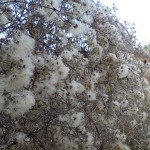
The Wildflower Garden in January
Although traditional gardeners often dread mid winter, a wildflower garden can be a place of fascination at this time of year. By early month it should already be possible to hear great tits singing. Their song, a repetitive and metallic “tea cher” “tea cher” is one of the first signs that spring is approaching. As the days slowly lengthen, Mistle thrushes can also be heard singing high in the treetops. They are one of our first birds to breed and during a mild winter may already have started nest building by the end of the month. If you regularly provide food for garden birds then you may well be rewarded by several unusual visitors this month, for in harsh weather Redwings and Fieldfares often move into wildflower gardens from the surrounding countryside, in search of fruit and berries. If you provide hanging peanuts or have planted alders you may also be fortunate enough to attract Siskins. Finally an increasingly common winter visitor to bird tables and berry bearing shrubs is the Blackcap, a small grey bird that, as its name suggests, has a dull black (or in the case of the female brown) head. As for mammals, it may be possible to see hedgehogs and foxes this month, both of which will sometimes leave their winter hideouts to search for worms, slugs and beetles. Plant life is naturally sparse at this time of year, however the first aconites will sometimes appear before the end of the month and there is little to beat the sight of snowdrops emerging through melting snow.
Tasks and tips for this month
January is the best month for planning a new wildlife or wildflower garden. The 3 most important habitats are ponds, wildflower meadows and woodlands and if you wish to include any of these it is essential to put pen to paper before you start digging! Consider the best places to site each habitat, for example a healthy pond will require a certain amount of sunlight and a wildflower meadow should ideally be sited in an area of the garden where soil fertility is poor and also where it can be cut regularly. A steep bank where the soil is fertile would for example be best used for growing some new trees or shrubs rather than wildflowers. If you wish to include woodland plants but do not yet have any mature trees then consider utilizing the north or east side of existing fence panels and hedges where little or no sunlight is received. This can often be as effective as planting in mature woodland! A full range of Wildflower seeds, mixtures, plugs and bulbs for the wildflower garden can be ordered through through our website. Please click the following link to browse our range of products www.wildflowersuk.c